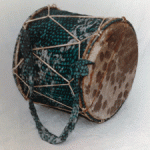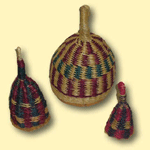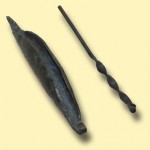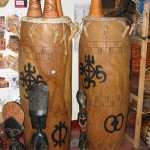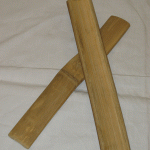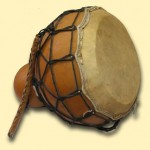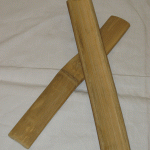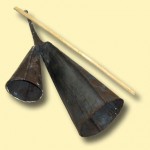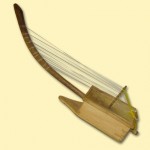Location:
The Ashantis inhabit the central and Southern Ghana.
Religion:
Nyame is their god their one supreme being. Never worshiped directly but through deities, cults and totems. Various attributes of Supreme Being are personified in objects. Moon Goddess Given birth to all men. Sky God Father God, who made the world with his hands. Sun God Male aspect of the moon. All these Gods are seen through trees, rivers rocks etc.
Festivals:
Festivals affirming values of the society, strengthening bonds.
Traditional Powers:
Akan system resolves around the chief based on a matriarchal lineage system. Succession to property as well as political office through the matrilineal line. Elders are councilors to the chief. The chiefs ruling over the clan being the administrators, religious head and military head. Present day they are administrators and custodians of the land. Conflicts at a public and private level are settled in arbitration courts instituted by the chiefs and the elders.
Music :
Music permeates all cultural activities of Akans from cradle to death. Marking all stages of life. Birth, puberty, adulthood, marriage, initiation rites, death. Religious rites, recreation, economic activities and political situations.
Language:
Language is Akan which is divided into Ashanti, Fante Akuapem, Akyem and Kwayu, the written from is Twi.
Economy:
Economically very diverse. Coastal Fantes depend on fishing, further inland. Farming coco, citrus, gold mining, timber production, modern commerce. Kente cloth Adinkra, carving, bronze.
Kente Cloth:
In Ghana traditional weaving is done by men of the Ewe and Ashanti tribes. Who is more innovative depends on your source of information. The Ewe migrated from the north and their famous weaving villages are in the Volta Region along the path of migration. Ewe work is distinguished by animal, human and symbolic patterns woven into the cloth. The Ashanti are located in the Central Region and are known for their traditional crafts. Ashanti cloth is usually geometric in design. Both groups excel at weaving cloth fit for a king, and originally Kente was only worn by kings, chiefs or people in very prominent positions. Now, it is available to all, but because of its expense, it is still the cloth of prestige.
Adinkra:
Adinkra is a type of cloth made by the Ashanti people of Ghana with a thick black plant dye. The dyers use stamps carved from calabash to cover cloth with patterns. There are over a hundred patterns referring to Ashanti proverbs, historic people, animals and events.Adinkra is traditionally worn at funerals and at times of mourning. Adinkra printed on black, brown, red, or purple cloth is worn from the period from death to the burial of the deceased person. Adinkra on white is worn for the post-burial celebration.Adinkra is a printed or stamped traditional cloth made by the Ashanti people in Ghana. The centre of production is the village of Ntonso, where the cloth has been made for a long time, though no-one knows how long. When the printers are asked, they say, “we Ashanti don’t use dates or numbers. It was a long, long time ago.”Adinkra is a printed or stamped traditional cloth made by the Ashanti people in Ghana. The centre of production is the village of Ntonso, where the cloth has been made for a long time, though no-one knows how long. When the printers are asked, they say, “we Ashanti don’t use dates or numbers. It was a long, long time ago.”At one time, Adinkra cloth was only worn for funerals. The fabric you wore, and how you wore it, depended on your relationship to the deceased, and the symbols on the clothes contained messages in their patterns. Nowadays Adinkra cloth is used for other celebrations, and young Ghanaians wear white Adinkra for weddings. The fabric can only be used for special occasions, however, as it is not designed to be washed! The garments are dyed black with the boiled-up roots of the Kuntunkuni tree. These trees only grow on the northern savannah and the women have to travel out to markets in northern villages to buy the roots. The garments are dipped, soaked, and left to dry until they are black; it can take ten dippings for a pale-coloured garment. The dye for the stamps is made from the bark of the Badie tree. The bark has to be softened in water, pounded all day, and then boiled until a thick brown dye is produced. This thick, syrupy dye is called ‘medicine’ or ‘adinkra aduru’.The carver cuts the stamp out of the bottom of a calabash piece (a calabash is a type of gourd). The stamps measure about five or eight centimetres square. They have a handle on the back, and the stamp itself is slightly curved, so that the dye can be put on with a rocking motion. There are more than 70 different stamps, all with their own meaning. They represent the proverbs, beliefs and hopes of the printer and of the person wearing the garment.The cloth is stretched flat across planks padded with flax, and then nailed down. Then the fabric is divided into sections using a large, wooden comb dipped in dye. Next the symbols are printed into the sections. The printer dips the stamps into the pot of dye, whips off excess dye and stamps the fabric with a quick rolling motion to ensure the dye goes on evenly. The printers make no measurements or plans, but instead hold in their memories special patterns and formats. For each garment, they choose designs and stamps that they like, and a message which they wish to convey.When the garment has dried, it is ready to wear – but the dyes used will run in water and fade in the sun. Because of this, the cloths need to be redyed again and again.


